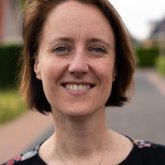PhD position in Simulation of Thermoplastic Composites Manufacturing for Aerospace Applications
Are you passionate about composite materials and cutting-edge manufacturing technologies? Do you want to contribute to the future of sustainable aviation? If so, these PhD positions may be the perfect fit for you!
The PhD positions
Press forming of thermoplastic composites
Press forming is a manufacturing technology for producing small to medium-sized thermoplastic composite components in high volumes. Process simulation software is being developed for virtual optimization of tool design and material handling, enabling first-time-right manufacturing. The predictive quality of these tools relies on accurate constitutive models that describe the behavior of the molten material during forming. With the increasing demand for more complex components, a step change in model accuracy and associated material characterization methods is required.
For this purpose, we are looking for two PhD candidates to tackle the rheological characterization and constitutive modelling of molten unidirectionally reinforced thermoplastic composites.
Position 1 – Ply and blank bending during hot press forming
Wrinkling is one of the primary process-induced defects in press-formed thermoplastic composite parts. Predicting wrinkling requires accurate constitutive models for the bending behavior of molten reinforced thermoplastic plies, which in turn depends on careful rheological characterization.
In this project you will:
• Perform rheological experiments to characterize the bending behavior of molten UD reinforced thermoplastic plies and laminates.
• Develop constitutive models that accurately describe the effects of temperature, bending rate and fiber orientation.
• Implement the developed models in commercial forming simulation software and validate their accuracy against forming experiments.
We are looking for a colleague who is comfortable with experimental work, has experience in polymer rheology and can implement constitutive models in Matlab or Python.
Position 2 – Ply/ply and tool/ply friction during hot press forming
Excessive friction between the plies in a laminate or between the outer plies and the tool surfaces can lead to defects during hot press forming. Accurate prediction of such defects requires both careful experimental characterization of frictional behavior and advanced constitutive models to describe it.
In this project, you will:
• Experimentally characterize ply-ply and tool-ply friction under a variety of processing conditions using our novel improved in-house developed friction tester.
• Critically evaluate earlier developed friction models and extend them to account for effects such as slip direction and temperature dependence.
• Implement the developed models in commercial forming simulation software and validate their accuracy against forming experiments.
We are looking for a colleague who is comfortable with experimental work, has experience in polymer rheology and can implement constitutive models in Matlab or Python.
Laser-assisted automated fiber placement
Laser-assisted fiber placement (LAFP) is an additive manufacturing technology for thermoplastic composites. A laser heats both the incoming tape and the substrate locally, which are then fused and consolidated under pressure from a compaction roller. LAFP is particularly attractive for manufacturing large structures such as fuselage and wing panels.
Reliable process control is critical: underheating leads to poor bonding, while overheating causes polymer degradation. At the heart of process control algorithms lies a physics-based simulation model, whose accuracy largely determines the effectiveness of the control loop.
Position 3 – High-fidelity simulation of the LAFP process
Current simulation models do not fully capture the complex, temperature-dependent, anisotropic, and evolving optical and thermal properties of thermoplastic composite materials. In addition, the desired prediction accuracy requires high spatial and temporal resolution, which is time-prohibitive and therefore impractical for large parts. This project therefore aims to develop numerical methods that enable the efficient simulation of the LAFP process while accounting for the aforementioned complexities.
In this project, you will:
· Develop and implement a multiscale – both spatial and temporal – numerical framework that enables efficient LAFP process simulations of large structures while still capturing the relevant thermal history with sufficient accuracy.
· Develop and implement an accurate and efficient optical model to calculate the laser heat flux on tape and substrate.
· Couple the two models and validate the result on an industrially relevant part.
We are looking for a colleague who has a very strong background in mathematical derivation and implementation of numerical methods for multiscale field problems. In addition, experience with high performant computing languages is desired, while knowledge of available third-party simulation tools such as `gmsh` is regarded as helpful.
Induction welding
Induction welding enables the assembly of thermoplastic composite parts through fusion. The process uses an alternating magnetic field to generate eddy currents in the carbon fiber reinforcement, which in turn causes localized heating and melting of the interface between parts. Once cooled, this results in a strong welded joint. Induction welding is attractive because it is contactless, requires no foreign material at the interface, and can be highly automated. However, current process and tool design often relies on trial-and-error approaches with extensive dry-runs.
Position 4 – Efficient simulation of the induction welding process
Process simulations can provide a cost-effective alternative to determine processing windows as well as to optimize the tooling geometry. These process simulations require efficient numerical algorithms to be practical and to enable robust optimization.
Therefore, in this project you will:
• Develop efficient numerical methods and strategies to solve the electromagnetic and heat transfer problem in induction welding.
• Develop constitutive models that capture the temperature dependence of anisotropic electrical conductivity.
• Implement the developed models and validate them against welding experiments.
We are looking for a colleague who has experience in deriving and implementing numerical methods to solve 3D field equations, has a solid understanding of electromagnetism, and is proficient in numerical computing software such as Python, Matlab or Julia.
Information and application
Please submit your application before 25 September 2025, using the “Apply now” button, and include:
- A Curriculum Vitae, including contact information for at least two academic references;
- A cover letter of at most one page. In this cover letter you will indicate your preferred PhD position (only one) and explain why you believe you are the best candidate, while referring to your background knowledge and past experience.
- Transcripts from your Bachelor and/or Master degrees.
Interviews will be held on 7th and 10th of October 2025.
Additional information about this position can be acquired from dr.ir. Wouter Grouve (w.j.b.grouve@utwente.nl).
A screening is part of the selection procedure.
About the organisation
The Faculty of Engineering Technology (ET) engages in education and research of Mechanical Engineering, Civil Engineering and Industrial Design Engineering. We enable society and industry to innovate and create value using efficient, solid and sustainable technology. We are part of a ‘people-first' university of technology, taking our place as an internationally leading center for smart production, processes and devices in five domains: Health Technology, Maintenance, Smart Regions, Smart Industry and Sustainable Resources. Our faculty is home to about 2,900 Bachelor's and Master's students, 550 employees and 150 PhD candidates. Our educational and research programmes are closely connected with UT research institutes Mesa+ Institute, TechMed Center and Digital Society Institute.




